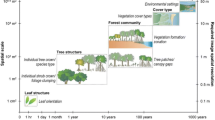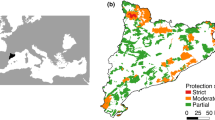Abstract
An ecosystem approach is the only way to conserve habitats and the enormous number of species. The related area-based Aichi biodiversity target of the convention on biological diversity aims to conserve at least 17% of terrestrial environment by 2020. This is the first regional study to recognize a network of key habitats to achieve conservation goals. It is essential to have a spatial framework by creating the indicator using existing remote sensing-based data. In this work, conservation principles were integrated at the ecosystem level covering irreplaceability and vulnerability along with representativeness. Forest persistence, ecosystem rarity, forest intactness, landscape-level ecosystem, biomass carbon stocks, and biological richness were among the biological criteria used to analyze ecosystem irreplaceability. The proxies used for ecosystem vulnerability are high fragmentation, fire hotspots and proximity to disturbance factors. A unique value is assigned to each individual pixel in the prioritization map. Overall representation of habitat coverage in protected area network of South Asian countries indicates under-representation of several forest types with less than 17% coverage. The overlay of the priority areas proposes that there is a possibility of conserving many species with the notification of protected areas. This study demonstrates the conservation priorities by identifying key habitats based on multiple conservation principles.









Similar content being viewed by others
References
Arponen A, Lehtomäki J, Leppänen J, Tomppo E, Moilanen A (2012) Effects of connectivity and spatial resolution of analyses on conservation prioritization across large extents. Conserv Biol 26:294–304
Asaad I, Lundquist CJ, Erdmann MV, Costello MJ (2017) Ecological criteria to identify areas for biodiversity conservation. Biol Conserv 213:309–316
ASEAN-Secretariat (2003) ASEAN declaration on heritage parks adopted by the environment ministers at the 9th ASEAN ministerial meeting in Yangon, Myanmar on 18 December 2003. Association of South East Asian nation’s secretariat, Jakarta-Indonesia
Athira K, Reddy CS, Saranya KRL, Joseph S, Jaishanker R (2017) Habitat monitoring and conservation prioritisation of protected areas in Western Ghats, Kerala. India. Environ Monit Assess 189:295
Austin KG, Lee ME, Clark C, Forester BR, Urban DL, White L, Poulsen JR et al (2017) An assessment of high carbon stock and high conservation value approaches to sustainable oil palm cultivation in Gabon. Environ Res Lett 12:36. https://doi.org/10.1088/1748-9326/aa5437
Bax V, Francesconi W, Quintero M (2016) Spatial modelling of deforestation processes in the Central Peruvian Amazon. J Nat Conserv 29:79–88
Bloom DE, Rosenberg L (2011) The future of South Asia: population dynamics, economic prospects, and regional coherence. WDA-Forum. University of St, Gallen
Brooks T (2010) Conservation planning and priorities. Conservation biology for all. Oxford University Press, Oxford, pp 199–217
Brooks TM et al (2006) Global biodiversity conservation priorities. Science 313:58–61
CBD (2004) The ecosystem approach, (CBD Guidelines). Secretariat of the Convention on Biological Diversity, Montreal, p 50
CBD (2008) Report of the on criteria scientific meeting experts’ workshop for identifying ecologically and biologically significant areas beyond national jurisdiction, 6–8 December 2005, Ottawa, Canada
CBD (2009a) Azores scientific criteria and guidance for identifying ecologically or biologically significant marine areas and designing representative networks of marine protected areas in open ocean waters and deep sea habitats. UNEP/CBD/EWBCS&IMA, Montreal, p p10
CBD (2009b) Report of the expert workshop on scientific and technical guidance on the use of biogeographic classification systems and identification of marine areas beyond national jurisdiction in need of protection. UNEP/CBD/EWBCS&IMA, Montreal
CBD (2010) Strategic plan for biodiversity 2011–2020, including the aichi biodiversity targets. Secretariat of the Convention on Biological Diversity, Montreal
Clark NE, Boakes EH, McGowan PJ, Mace GM, Fuller RA (2013) Protected areas in South Asia have not prevented habitat loss: a study using historical models of land-use change. PLoS ONE 8(5):e65298
Clark MR, Rowden AA, Schlacher TA, Guinotte J, Dunstan PK et al (2014) Identifying Ecologically or Biologically Significant Areas (EBSA): a systematic method and its application to seamounts in the South Pacific Ocean. Ocean Coast Manag 91:65–79
Collen B, Pettorelli N, Baillie JEM, Durant S (2013) Biodiversity monitoring and conservation: bridging the gap between global commitment and local action. Wiley-Blackwell, Cambridge
Cowling RM, Pressey RL, Rouget M, Lombard AT (2003) Conservation plan for a global biodiversity hotspot: the Cape Floristic Region. S Afr Biol Cons 112:191
Crowder L, Norse E (2008) Essential ecological insights for marine ecosystem-based management and marine spatial planning. Mar Policy 32(5):772–778
Cruz-Huerta C, González-Guillén MDJ, Martínez-Trinidad T, Escalona-Maurice M (2017) Identifying priority conservation areas for above-ground carbon sequestration in Central Mexico. IForest 10:923–929
EEA (2016) European forest ecosystems—State and trends. European Environment Agency, Luxembourg. EEA report No. 5/2016
FAO (2007) Manual on deforestation, degradation, and fragmentation using remote sensing and GIS. Strengthening monitoring, assessment and reporting on sustainable forest management in Asia. FAO, (GCP/INT/988/JPN). MAR-SFM Working Paper 5/2007, Rome
Forman RT, Godron M (1986) Landscape ecology. Wiley, New York
Getis A, Ord J (1996) Local spatial statistics: an overview. In: Longley P, Batty M (eds) In spatial analysis: modeling in a GIS environment. GeoInformation International, Cambridge, pp 269–294
Gilman E, Dunn D, Read A, Hyrenbach KD, Warner R (2011) Designing criteria suites to identify discrete and networked sites of high value across manifestations of biodiversity. Biodiv Cons 20(14):3363–3383
Hughes J, Daily G, Ehrlich P (2000) Conservation of insect diversity: a habitat approach. Cons Biology 14(6):1788–1797
https://earthdata.nasa.gov/data/near-real-time-data/firms/active-fire-data/
Iniguez JM, Thomas WS, Stephen RY (2008) Topography affected landscape fire history patterns in southern Arizona. USA. Forest Ecol Manag 256(3):295–303
IUCN (2016) A global standard for the identification of key biodiversity areas version 1.0. first edition. International Union for Conservation of Nature (IUCN), Gland, Switzerland
Juffe-Bignoli D, Harrisonb IC, Butchartd SHE, Flitcroft FR, Hermosog V et al (2016) Achieving Aichi biodiversity target 11 to improve the performance of protected areas and conserve freshwater biodiversity. Aquat Conserv 26(1):133–151
Kerr JT, Ostrovsky M (2003) From space to species: ecological applications for remote sensing. Trends Ecol Evol 18:299–305
Kullberg P, Moilanen A (2014) How do recent spatial biodiversity analyses support the convention on biological diversity in the expansion of the global conservation area network? Nat Conservacao 12(1):3–10
Laurance WF, Lovejoy TE, Vasconcelos HL, Bruna EM, Didham RK, Stouffer PC, Gascon C, Bierregaard RO, Laurance SG, Sampaio E (2002) Ecosystem decay of amazonian forest fragments: a 22-Year investigation. Conserv Biol 16:605–618
Lombard AT, Hilton-Taylor C, Rebelo AG, Pressey RL, Cowling RM (1999) Reserve selection in the Succulent Karoo, South Africa: coping with high compositional turnover. Plant Ecol 142:35–55
Lonsdale WM (1999) Global patterns of plant invasions and the concept of invasibility. Ecology 80:1522–1536
Malcolm JR, Ray JC (2000) Influence of timber extraction routes on Central African small mammal communities, forest structure, and tree diversity. Conserv Biol 14:1623–1638
Marks PL (1995) Reading the landscape: primary vs. secondary forests. Arnoldia 55(3):2–10
Nackoney J, Williams D (2012) Conservation prioritization and planning with limited wildlife data in a Congo Basin forest landscape: assessing human threats and vulnerability to land use change. J Conserv Plann 8:25–44
Nagendra H, Lucas R, Honrado JP, Jongman RH, Tarantino C, Adamo M, Mairota P (2013) Remote sensing for conservation monitoring: assessing protected areas habitat extent, habitat condition, species diversity, and threats. Ecol Indic 33:45–59
Pereira HM et al (2013) Essential biodiversity variables. Science 339:277–278
Plantlife International (2004) Identifying and protecting the world’s most important plants area (ipa); a guide to implementing target 5 of the global strategy for plant conservation. Plantlife International, Salisbury
Pressey R, Humphries C, Margules CR, Vane-Wright R, Williams P (1993) Beyond opportunism: key principles for systematic reserve selection. Trends Ecol Evol 8(4):124–128
Reddy CS, Khuroo AA, Hari Krishna P, Saranya KRL, Jha CS et al (2014) Threat evaluation for biodiversity conservation of forest ecosystems using geospatial techniques: A case study of Odisha, India. Ecol Eng 69:287–303
Reddy CS, Jha CS, Diwakar PG, Dadhwal VK (2015) Nationwide classification of forest types of India using remote sensing and GIS. Environ Monit Assess 187(12):1–30
Reddy CS, Manaswini G, Satish KV, Singh S, Jha CS et al (2016a) Conservation priorities of forest ecosystems: Evaluation of deforestation and degradation hotspots using geospatial techniques. Ecol Eng 91:333–342
Reddy CS, Jha CS, Dadhwal VK, Harikrishna P, Pasha SV et al (2016b) Quantification and monitoring of deforestation in India over eight decades (1930-2013). Biodivers Cons 25:93–116
Reddy CS, Satish KV, Jha CS, Diwakar PG, Krishna Murthy YVN et al (2016c) Development of deforestation and land cover data base for Bhutan (1930–2014). Environ Monit Assess 188:658
Reddy CS, Pasha SV, Jha CS, Diwakar PG, Dadhwal VK (2016d) Development of national data base on long-term deforestation (1930–2014) in Bangladesh. Glob Planet Change 139:173–182
Reddy CS, Rakesh F, Jha CS, Singh S, Athira K et al (2016e) Geospatial assessment of long-term changes in carbon stocks and fluxes in forests of India (1930–2013). Glob Planet Change 143:50–65
Reddy CS, Singh S, Dadhwal VK, Jha CS, Rama Rao PN et al (2017a) Predictive modelling of the spatial pattern of past and future forest cover changes in India. J Earth Syst Sci 126:8
Reddy CS, Manaswini G, Jha CS, Diwakar PG, Dadhwal VK (2017b) Development of national data base on long-term deforestation in Sri Lanka. J Indian Soc Remote. https://doi.org/10.1007/s12524-016-0636-8
Reddy CS, Singh J, Jha CS, Diwakar PG, Dadhwal VK (2017c) Development of spatial database on intact forest landscapes of India. Glob Planet Change 148:131–138
Reddy CS, Alekhya PVVL, Saranya KRL, Athira K, Jha CS et al (2017d) Monitoring of fire incidences in vegetation types and Protected Areas of India: Implications on carbon emissions. J Earth Syst Sci 126:11
Reddy CS, Jha CS, Manaswini G, Alekhya VVLP, Pasha SV, Satish KV, Diwakar PG, Dadhwal VK (2017e) Nationwide assessment of forest burnt area in India using Resourcesat-2 AWiFS data. Curr Sci 112(7):1521–1532
Reddy CS, Jha CS, Dadhwal VK (2018a) Earth Observations based conservation prioritization in Western Ghats, India. J Geol Soc India 92:562–567
Reddy CS, Saranya KRL, Pasha SV, Satish KV, Jha CS et al (2018b) Assessment and monitoring of deforestation and forest fragmentation in South Asia since the 1930s. Glob Planet Change 161:132–148
Reddy CS, Pasha SV, Satish KV, Saranya KRL, Jha CS et al (2018c) Quantifying nationwide land cover and historical changes in forests of Nepal (1930–2014): Implications on forest fragmentation. Biodivers Cons 27:91–107
Roy PS, Kushwaha SPS, Murthy MSR, Roy A, Kushwaha D, Reddy CS, Behera MD, Padalia H, Mathur VB, Singh S, Jha CS, Porwal MC (2012) Biodiversity characterisation at landscape level: national assessment. Indian Institute of Remote Sensing, Dehra Dun 1–254
Sierra R, Campos F, Chamberlin J (2002) Assessing biodiversity conservation priorities: ecosystem risk and representativeness in continental Ecuador. Landsc Urban Plan 59(2):95–110
Thomas CD, Anderson BJ, Moilanen A, Eigenbrod F, Heinemeyer A et al (2013) Reconciling biodiversity and carbon conservation. Ecol Lett 16:39–47
Toman MA (2010) India and global climate change: perspectives on economics and policy from a developing country. Routledge, London
UNESCO (2013) Operational guidelines for the implementation of the world heritage convention. WHC. 13/01. UNESCO World Heritage Centre, Paris
Wu R, Long Y, Malanson GP, Garber PA, Zhang S, Li D, Duo H et al (2014) Optimized spatial priorities for biodiversity conservation in China: a systematic conservation planning perspective. PLoS ONE 9(7):e103783
Acknowledgements
The present work has been carried out as part of ISRO’s National Carbon Project. We thank ISRO-DOS Geosphere Biosphere Programme for financial support. We are grateful to Shri Santanu Chowdhury, Director, NRSC, Dr. P.G. Diwakar, Director, E.D.P.O., Indian Space Research Organisation and Dr. P.V.N. Rao, Deputy Director, RSA, NRSC for suggestions and encouragement. We express our gratitude to Dr. P.S. Roy, Project Director, DBT-DOS Landscape level biodiversity project and project team for sharing the biological richness map of India. We are grateful to NASA and USGS for providing ready access to the MODIS data and Landsat data respectively. We acknowledge the anonymous reviewers for comments that significantly improved the manuscript.
Author information
Authors and Affiliations
Corresponding author
Additional information
Communicated by M. D. Behera, S. K. Behera and S. Sharma.
Rights and permissions
About this article
Cite this article
Reddy, C.S., Faseela, V.S., Unnikrishnan, A. et al. Earth observation data for assessing biodiversity conservation priorities in South Asia. Biodivers Conserv 28, 2197–2219 (2019). https://doi.org/10.1007/s10531-018-1681-0
Received:
Revised:
Accepted:
Published:
Issue Date:
DOI: https://doi.org/10.1007/s10531-018-1681-0




